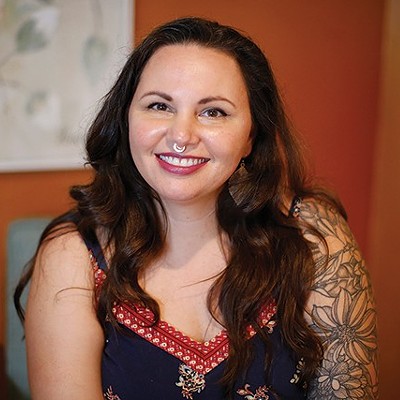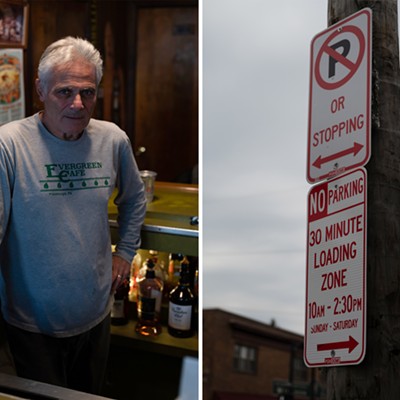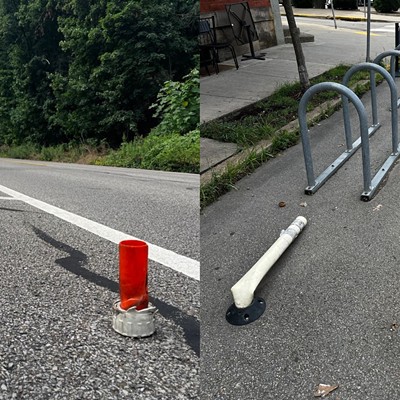How the West Wasn't Won
A West Pittsburgh development group's closed-door dealings have cost it the trust of some needy neighbors
[
{
"name": "Local Action Unit",
"component": "24929589",
"insertPoint": "3",
"requiredCountToDisplay": "1"
}
]
In the back corner of the courtyard at the James Gallery stands a striped metal steed with a somewhat ridiculous turkey-like head. It's called "Trojan Horse Study Number 2," and it's the creation of artist Rick Bach. It wouldn't be in this quiet spot in the West End's eight-block business district were it not for the West Pittsburgh Partnership, a community development group run by a small band of merchants, developers and residents.
If Bach's horse is the most colorful symbol of their revitalization efforts, though, it's also an apt metaphor for way the Partnership is viewed by some neighborhood activists: with hope, but also nagging suspicion about what's really happening on the inside.
Since 1985, the West Pittsburgh Partnership has turned the West End from a dusty post-industrial nook to one of the city's up-and-coming business districts. Across from the James Gallery stands the new West End Park House restaurant. Down a recently redone sidewalk is a revitalized bank building. Long-empty storefronts wear fresh "For Rent" signs, and the smell of sawdust drifts out of apartments under renovation.
But in the neighborhoods west of West End -- those knobby urban fingers that stretch to suburban Robinson and Carnegie -- there's a sense of precarious balance. Elliott's new senior housing is just a short walk from shuttered shops. Sheraden's bustling industrial park sits below residential streets reeling from the onslaught of absentee landlords. Westwood's relatively new, suburban-style homes contrast with Esplen's crumbling stock.
The Partnership has made efforts to tip the balance in nearby neighborhoods. But budget problems, bitterness over an aborted city program, the Partnership's closed-door meetings and its real-estate sales to its own board members have prompted some neighborhood activists to start looking this gift horse in the mouth.
"We're just a little bitty finger of land that can easily be forgotten," says Norene Beatty, president of the West End Elliott Citizens Council, which holds monthly resident meetings and advocates for the neighborhood.
For a time, being forgotten wasn't so bad. Originally called Temperanceville because the original land deeds forbade the sale of alcohol, the West End's location at the base of the Ohio attracted saw mills, grist mills, iron works and an oil refinery. But it never developed on the grand scale of the Mon Valley or Aliquippa. Neighboring Elliott was a mining town, and Sheraden went from farmland to one of the region's early "bedroom communities," featuring affordable homes for rail and mill workers. After World War II, public housing gave rural Fairywood a suddenly urban flavor. Meanwhile, people moving out of the city's older neighborhoods turned Chartiers City, Crafton Heights and Windgap, and later Oakwood, Ridgemont and Westwood, into suburban-style boomtowns. They rarely made the news. They just grew.
By the time Beatty joined the Citizen's Council in 1968, the forces that would undermine the west were already in motion. "We witnessed the same white flight that other communities witnessed," she says. As for the mom-and-pop atmosphere of the area's business districts, she says, "We killed it. ... We got in our cars and drove to the big shopping centers."
Still, locals say west Pittsburgh's rowdy vibrancy and gruff camaraderie live on. "You were 15," says S. M. "Sandy" Stevenson, now 62, who grew up in Westwood. "You had a fistfight, and then went down and bought a beer for a quarter and drank it with the guy you just beat up, or who just beat you up." That's what made him who he is, he says. "I'm a fighter."
Stevenson's also an electrical engineer, inventor, developer and a key figure -- albeit a controversial one -- in the fight to rebuild his old stomping ground.
Though he's now a Peters Township resident, in 2000 Stevenson co-founded a development company, Halapin & Stevenson, bought a large house on Wabash Street and began converting it into offices.
Later that year, National City Bank announced it would move out of a key building at the corner of Wabash and South Main, causing panic in the West End business community. "Imagine coming to a community, and your only bank wants to leave," says Mary Dru Imler, who had just taken her current job as the West Pittsburgh Partnership's executive director. Given 90 days warning by National City, Imler cast about desperately for a buyer, and found Stevenson.
Stevenson's company bought the building for $200,000 in December 2000. He joined the Partnership's board in November 2001. "I've been building my whole damned life, and I figured maybe it was time to give something back," he says. The following month, the Partnership loaned him $150,000, at an attractive 2 percent interest rate, to help refurbish the property. He later took out a $1.6 million mortgage from a for-profit lender, which helped finance some $2 million in renovations.
The bank building now houses the Westmoreland Suzuki School of Music, Rosie's Café and the European Treasures gift shop, which cleverly reuses the old bank vault. National City was even persuaded to retain a small branch. There are vacancies, though. "The building is still upside down," says Stevenson, meaning his debt payments are greater than the rent he receives.
Nonetheless, in 2004, Stevenson bought another property, under circumstances that have raised eyebrows. Chemical company Ferro Corp. had let several large, yellow brick buildings along Chartiers Avenue in Crafton Heights stand empty for years. Stevenson talked with Ferro executives. "I said, 'Donate it and take the tax write-off,'" Stevenson recounts. "I said, 'I'm on the board of the West Pittsburgh Partnership, and maybe they'll take it.'"
"We couldn't take it unless we had someone to sell it to," says Ned Gensler, president of the Partnership. So before actually taking title, the Partnership advertised the four parcels for sale for several weeks, he says. There were no takers.
"Then I said, 'Let's make a deal: I'll buy it,'" says Stevenson. On June 9, 2004, Ferro sold the parcels to the Partnership for $1. At the time, the county assessed the parcels as having a market value of $575,000. Six days later, Dysan Development -- a company owned by Stevenson's wife, Diane -- bought them from the Partnership for $100,000. (The county subsequently lowered its assessment to $105,700.) Dysan paid $25,000 in cash and agreed to pay the other $75,000 over 10 years. The Partnership is charging Dysan 5 percent interest on the balance, according to an unsigned response it sent to City Paper's financial questions.
The Partnership uses the proceeds from property sales to help fund its activities, according to tax filings.
Stevenson says he's already spent $200,000 pressure-washing the Ferro buildings, fixing the roofs, upgrading the utilities and putting in heating and air conditioning. He has just one tenant -- a weekend flea-market operator. Circle C Youth and Family Services has expressed interest in buying one building for an undisclosed price, but must first raise money to cover the purchase and renovations.
Though there's enthusiasm about the possibility of Circle C moving to the area, the Dysan deal rankles some community members. "Sandy Stevenson is on their board, and now he has all that property out there," says Beatty. "It's not for people who sit on [nonprofit] boards to be making money on it."
"If a certain board member is interested in a property, we facilitate that person the same as we would a person from outside," says Gensler. Board members don't participate in deliberations or vote on matters in which they might have a financial stake, he says. To exclude board members from opportunities, Gensler says, would be to "penalize someone who's volunteering their time."
The Dysan sale wasn't the first time the Partnership had purchased a property which it then sold to one of its own board members. In 2000 it bought a lot on Wabash Avenue for $19,000 and three months later sold it, for $25,000, to Gensler. He uses it as a parking lot for his business, Caldwell's Windoware. In 2001, it bought a house on South Main for $13,000; it sold it for the same price to board member Ralph Hoffman in 2003. On its tax filings, the Partnership claims it suffered a loss on that deal, apparently because it paid $553 in costs.
"Every one of these deals I've seen are properties that no one else wanted," says Alan Hertzberg, a Partnership board member, former city councilor and recently appointed Common Pleas Court judge. "The properties were marketed, and a lot of times they didn't really have much of a market value."
IRS rules say nonprofits must "not be organized or operated for the benefit of private interests," including their creators and "shareholders." Since the Partnership receives federal Housing and Urban Development funding, it also falls under HUD's similar rules. HUD says any "employee, agent, consultant, officer, or elected official or appointed official" of an organization that gets community development funding may not "obtain a financial interest or benefit" from any activity aided by that funding. HUD includes those with "immediate family ties" to officials of the organization in its ban. It also explicitly includes real-estate transactions.
Did Gensler, Hoffman or Stevenson "obtain a financial interest or benefit" from buying properties from the Partnership? Hoffman's house, for which he paid $13,000, is now assessed at $18,400. The property Gensler bought for $25,000 is now assessed at just $800.
The $150,000 loan to Stevenson's partnership raises thornier questions. At 2 percent interest, it is well below market rate. It was made during the same year that the Partnership made two other loans, to businesses whose owners were not on its board, at 5 percent interest, according to its tax filings. The Partnership says in its written response that it has no formalized lending policy, and that its board determines interest rates based on "the purpose of the loan, the collateral for the loan, the borrower's ability to repay the loan" and other factors.
"Will I make money on this?" Stevenson asks. "I calculated on my cash flow that my estate's going to love it -- in about 19 years."
James Frederick and his business partner, Gayle Irwin, operated the James Gallery in Dormont for 28 years. In 2001, they went looking for a space that would offer more convenient access to the corporate art buyers who are their mainstay, and settled on the West End. "Every major road into and out of the city goes through the West End," says Frederick, exaggerating somewhat. Plus he was impressed with the pioneering spirit of the Partnership's board. "The West End seems to have a much more energetic merchant and business group -- very involved people, people with vision," he says. He and Irwin beautifully remodeled their South Main building, moved in operations including a framing shop, and are considering expanding to the building's second floor.
Irwin subsequently joined the Partnership's board, and thinks redevelopment in the West End will expand outward into the other western neighborhoods. "If you can cast the stone here, in this little valley," she says, "I think the ripple effects of something like that will spread out."
There's certainly a need for ripples. During the 1990s, the 12 western neighborhoods lost 14 percent of their population, compared to a 10 percent loss in the city as a whole. Hardest hit was Fairywood, where the closure of two large public housing communities reduced the population from 2,951 to just 1,099. Many of those displaced from Fairywood resettled in neighboring communities. That seems to have accelerated white flight: Sheraden alone lost nearly 1,400 white residents during the 1990s, while gaining nearly 800 African Americans.
"The baby boom population is dying off or moving out," says Mary Radford, president of the Sheraden Community Council. "A lot of those [homes] are being sold to rental agencies." Sheraden is battling for its share of scarce city money to repair city steps and sidewalks, get some dilapidated houses torn down, and finish a skate park. Radford's organization is also trying to unite the increasingly diverse community with events like neighborhood clean-ups and a March 22 boxing tournament that was cosponsored by the Partnership. Unfortunately, the community council can't take on big jobs like improvements to the commercial district, or a comprehensive housing plan, she says. For that, you need a community development corporation, she notes, and the only one in the western neighborhoods is the Partnership. Would she like to see the Partnership get more involved in redeveloping Sheraden? "I'd love them to," Radford says.
That feeling isn't universal. During the 1990s, for example, Esplen lost 17 percent of its residents, dipping below 500 people. With great views and easy access to Downtown, the neighborhood is "ripe" for redevelopment, says George Miller, president of the Esplen Citizens Council. "They could build some new housing," he says. But should the Partnership do the building? Miller is skeptical. "We are out of the way, you know what I mean? We don't fit in with their plans."
After taking over the Partnership in 2000, Imler took steps to widen its focus beyond the West End business district. She changed its name from the West End-Elliott Joint Project to the West Pittsburgh Partnership. In 2002, the Partnership helped transform the former Westlake School in Elliott into 27 apartments for low-income seniors. In 2002 and 2003, the Partnership bought two other properties in Elliott, and sold them to a company affiliated with Bear Communications of Mount Lebanon. One of the buildings is being renovated, while the other is being demolished to make way for new commercial development, says Ruth Hawk, the owner. In 2003 the Partnership also bought a house in Esplen, which it still owns.
Gensler says the Partnership has since "had to retrench" and concentrate on the West End business district, primarily because of financial constraints. Its budget peaked at $573,563 in 2002. In 2003, it raised just $314,581 -- of which 73 percent came from government sources -- and spent $346,885. That's a deficit of $32,304. The Partnership submitted a proposed 2004 budget of $427,900 to the Department of City Planning. But in a written response, it says it spent only $265,000, due to funding shortfalls.
For the moment, the Partnership is concentrating on West End's business district. It's working on a project called Stone Chapel Village, and a proposed walkway to the Ohio River, neither of which it will say much about. That's a pretty full plate for an organization that is down to two staff members.
Still, Gensler says the board recognizes that the West End's success depends on the health of the neighborhoods behind it, and vice-versa. "If a Crafton Heights comes to us, or a Sheraden does, and asks us for help, 'no' is not going to be the answer," he says. "We will not turn our backs on people."
Even if the Partnership had the resources to expand its operations, it might face resistance from some, thanks to bitterness over its highest-profile foray into the other western neighborhoods. Concerned about homeowner flight from western neighborhoods, Hertzberg and Mayor Tom Murphy in 2002 persuaded the Partnership to take the West End Home Assurance Value (WEHAV) program under its organizational wing. During WEHAV's brief existence, all owners of residential properties in the 12 neighborhoods had to pay an annual $20 fee per household. They had the option of paying an additional $125 to have their homes appraised by the WEHAV program. If, after five years, they sought to sell their homes but found that buyers were willing only to pay less than the appraised value, the WEHAV program would make up the difference. In theory, WEHAV would have discouraged people from fleeing by insuring the value of their homes.
The $20 assessment prompted a miniature Whiskey Rebellion, with the Partnership caught in the crossfire. A group of 33 residents sued the Partnership and the city to have the program terminated. Waves of WEHAV opponents regularly came before city council, offering a mixture of reasoned arguments and vitriolic accusations.
"The real problem with [WEHAV] was these negative people going out and putting out all kinds of garbage," says Hertzberg.
WEHAV "is symptomatic of top-down thinking that pays no attention to what's really going on in the neighborhoods," counters Paul Sentner, an Elliott resident, sometime photographer and art dealer, and WEHAV opposition leader. "Expensive homes don't make an area. City services do."
Sentner and others assembled some 3,200 signatures asking for WEHAV's termination. In September, city council ended the program, with only Hertzberg voting no.
In some ways, the Partnership made itself an easy target. "They're a pretty aloof bunch," says Jack Peth, of Crafton Heights, one of the anti-WEHAV leaders. Peth's compatriots often reminded council that most of the Partnership's leaders live outside the city.
Imler lives in McCandless. Just 7 of the Partnership's 19 board members live in the western neighborhoods. The others own West End businesses, but live in places like Upper St. Clair (Gensler, the president), Mount Lebanon (Irwin, of James Gallery) and Peters (Stevenson). "It's hard to find neighborhood people who have the time," explains Gensler. "It's a blue-collar area, and our meetings, as a rule, are at lunch time."
The Partnership conducts nearly all of its meetings behind closed doors, inviting the public just once a year. "If you're doing a project where property has to be assembled, you're not going to be able to let that out to the general public," explains Gensler. If you discuss planned developments in public, he says, speculators might then buy up the involved properties and demand top dollar.
Beatty, of the West End Elliott Citizens Council, says the culture of secrecy is taken to extremes. "Their board members are not allowed to talk about what goes on in their board meetings to anyone in the community," she says.
Combined with the practice of selling properties to board members, the closed meetings encourage suspicion, says Carl Suter, a Crafton Heights community activist who opposed WEHAV. "With no transparency in the organization, how do I know where the $100,000 [that Dysan paid for the Ferro properties] went?" he asks. "I think they need to open up the organization to the community, so we know what's really going on."
Community development corporations, including the 20-odd CDCs that serve Pittsburgh's low-income neighborhoods, occupy a space somewhere between government and the private sector. They are private organizations, so the "sunshine laws" that force governments to conduct most business in public don't apply. Nor do rules that force government officials to disclose their financial interests. But since CDCs exist to serve neighborhoods, and get most of their money from the government, there's often community pressure on them to conduct business as openly as possible.
Despite the unique role of CDCs in developing American communities, there are no widely accepted codes of conduct for them. The Washington-based National Congress for Community Economic Development has been working on standards for years, says NCCED Policy Director Carol Wayman. But of late, its attention has been on fighting proposed federal budget cuts.
That leaves CDCs to develop their own rules. The Bloomfield-Garfield Corp., for instance, conducts most of its meetings in public, even when it's discussing real-estate transactions. It rarely sells property to board members, and then only after a 90-day effort to sell it elsewhere, says BGC Executive Director Rick Swartz.
Lawrenceville Corp. has closed-door board meetings, but holds wide-open community planning meetings, and works closely with the residents' group Lawrenceville United. Lawrenceville Corp. recently adopted a written conflict-of-interest policy that requires board members to immediately disclose any benefit they might get from any proposed action. It offers the board a range of options, from having that member sit out deliberations and votes on that transaction, to having them resign.
When local CDCs face issues such as whether to transact business with board members, they often call in Mark Fatla, executive director of the Community Technical Assistance Center, which aids many neighborhood groups. "It's not necessarily wrong to transact business with a board member," Fatla says. But, he adds, "It's a sticky business, and it's different from circumstance to circumstance." If the transaction isn't "commensurate with conditions in the market," he says, it could violate IRS rules.
"Then there is a second concern in transacting business with board members," says Fatla. "That is the question of credibility with your public." Doing inside deals, he warns, "may cost you in terms of credibility."
Credibility is a particularly acute concern in places and times like the western neighborhoods post-WEHAV, Fatla says. "There are a lot of folks out there with their knives sharpened for this organization," he says of the Partnership. "The climate out there is highly charged. In that kind of atmosphere, such charges [of inside deals] have to be examined very carefully."
At the West End Overlook in Elliott, there's a $450,000 concrete concession building with a steel roll door that has been open just one day since its completion in 2003. Conceived by the Partnership and the West End Elliott Citizen's Council, and built by the city, it's become a source of tension between the three. The city has no money to operate it, the Citizens Council has a tiny budget and no staff, and the Partnership board doubts it can ever sustain itself. So it sits, its sightseeing platform unreachable, wires dangling from a busted light.
Just a few steps away is a stunning panorama of Pittsburgh, featuring a head-on view of the Golden Triangle, and a good look at the neighborhoods arrayed around it. That view could be the key to reinvigorating the west's housing market, says Beatty, of the West End Elliot Citizens Council. She unfurls a map that shows tax-delinquent properties, and points to a few city blocks near the overlook. "All that property is in sad condition. It could be had for a pittance by a developer," she says. A strong community development corporation could help make it happen. But the Partnership? "Ms. Imler informed us that housing is not her area of expertise," Beatty says. "We've tried to work with them. ... Because of their meetings being closed, we feel shut out."
In Sheraden, Radford takes in Brunot Avenue's view of the Ohio Valley and, off to the right, Downtown. Though there's industry across the river, up here it's all trees and chirping birds. "It's country living in the city," she says. Not far away, though, are broken windows, peeling paint, and lots of For Sale signs. There's "a huge shift toward rental," she says. "People who've lived in Sheraden, it's been their suburb, and now they've got to deal with a certain amount of urbanness."
Radford says Sheraden needs a housing plan, demolitions of some tax-delinquent properties, zoning changes to discourage owners from turning single-family homes into multi-unit apartments, sidewalk repairs and business district improvements. She says Sheraden needs the help of a vibrant West Pittsburgh Partnership. "They have the connections with the city that we don't have," she says. The whole area should take advantage of those connections, she says. "Everyone has to lay aside their personal feelings and the relationships they've had, and create new ones. Because otherwise, everything is going to be that much harder."


















